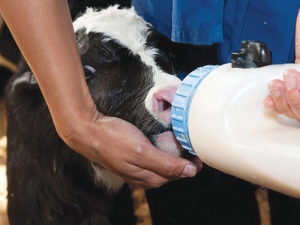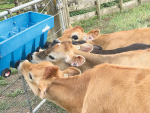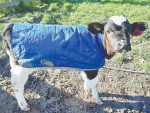Handheld digital or optical Brix refractometers offer a low cost, practical way to assess colostrum quality onfarm, and can help encourage famers to seek advice if colostrum is inadequate.
So says Katie Denholm, Gordonton veterinarian and InCalf advisor.
Pooling colostrum is a major risk factor for low concentration of the antibody Immunoglobulin G (IgG) in colostrum, Denholm told the recent NZ Veterinary Association conference.
Pooling colostrum is common practice on NZ dairy farms.
At least 90% of surveyed farmers pooled colostrum for feeding to newborn calves (Cuttance and Denholm unpublished observations). This practice can be problematic, as high production cows produce poor quality colostrum and so dilute the IgG content of the pool, Denholm says in a conference presentation.
In international literature, it is recommended that colostrum pooling be avoided despite its advantage of increasing the volume of colostrum available to newborn calves; problem is, pooling colostrum may increase risk of FPT (failure of passive transfer).
There is an inverse relationship between the volume of colostrum produced by an individual cow and the IgG concentration, with a resultant over-representation of high volume, low IgG colostrum in a pooled sample. There is also increased risk of disease where colostrum is pooled as multiple cows are present in a single colostrum feed.
In recent NZ work, 26% of farmers were pooling colostrum from later milkings with first-milking colostrum with a significant detrimental effect on colostrum.
Bacterial contamination of colostrum
As well as IgG concentration in colostrum, a major indicator of colostrum quality is bacterial contamination. Recent work in NZ shows that bacterial loads in first milking colostrum are exceedingly high, Denholm says.
Bacterial contamination of colostrum may reduce IgG absorption and increase risk of FPT. The mechanism by which bacteria (and specifically coliforms) interfere with IgG absorption is still unclear and she suggested a number of possibilities.
"Whatever the mechanism of action, it is clear that in NZ, colostrum samples are contaminated which could be a major risk for FPT," she says.
A previous study explored possible sources of bacterial contamination of colostrum and suggested multiple sources including secretion from the mammary gland, contamination during milking, contamination during storage or feeding and bacterial proliferation in stored colostrum.
"Clearly, careful employment of targeted management strategies may reduce much of this contamination risk, such as careful udder preparation prior to colostrum harvest, proper regular cleaning and sterilisation of calf feeding equipment, and storage using an approved preservative at the correct concentration and at refrigeration temperature," she says.
Discarding colostrum from infected cows and not pooling colostrum could also be effective management strategies.
"Practically speaking, to reduce bacterial loads farmers should endeavour to collect colostrum hygienically from the donor cows and store the colostrum in clean buckets or tanks. As the season progresses the risk of bacterial contamination of colostrum rises, so farmers need to maintain hygiene throughout the season even as calving fatigue sets in.
"Whether or not to pool colostrum should be carefully considered, and if pooling is deemed appropriate, animals to contribute to the pool should be carefully selected."
Denholm says few farmers clean feeding equipment regularly with hot soapy water, the required means of removing the fatty deposits left by colostrum and milk feeds; this would reduce bacterial build up.
Preserving colostrum quality
Farmers should be advised to store colostrum appropriately in lidded drums and to stir it regularly prior to feeding. Sick cows' colostrum should not be added to the pool and colostrum with clots should be avoided, she says.
Potassium sorbate is used in the wine and cheese industries and has been used in Australia effectively to preserve colostrum. In American work, potassium sorbate at ambient temperatures slowed the rate of bacterial growth and prevented or delayed fermentation process; however the effects of potassium sorbate were most beneficial during refrigeration.
Despite considerable evidence that bacterial proliferation is controlled by refrigeration of colostrums, very few NZ farmers have refrigeration for colostrum.
NZ work shows that potassium sorbate even at ambient temperatures is highly effective at preserving IgG concentrations and reducing bacterial loads.
Farmer education
Colostrum quality is an important determinant of subsequent calf health, Denholm says.
Anecdotally it appears relatively uncommon for farmers to assess colostrum quality, and benchmarks for colostrum quality have not been widely extended to farmers.
"Managerial practices such as routine testing of individual cows for colostrum harvest and routine testing of newborn calves, plus improved hygiene of collection and storage of colostrum would likely improve colostrum quality, reduce the risk of FPT and improve calf health on many NZ dairy farms."











